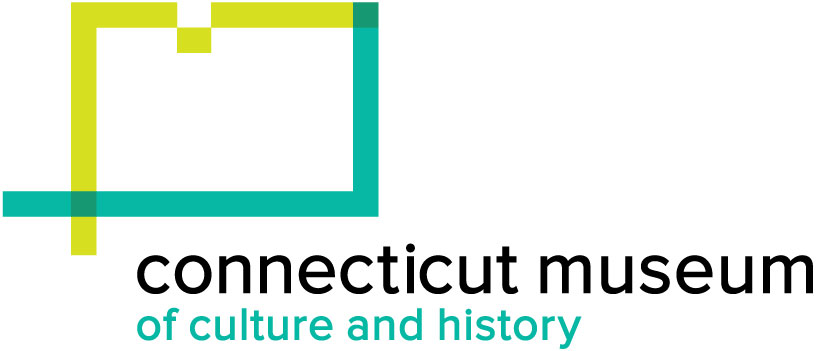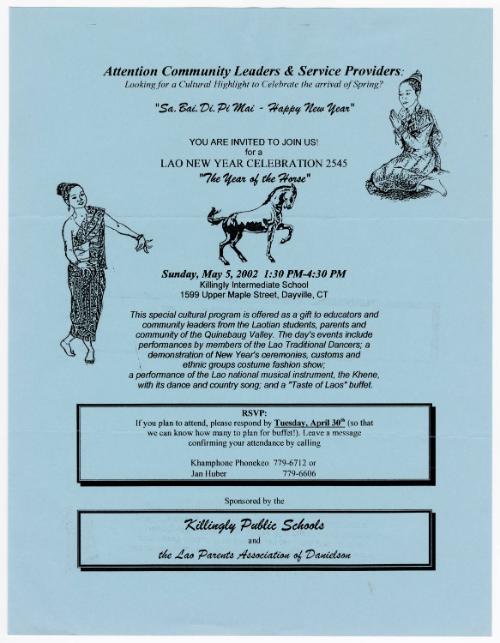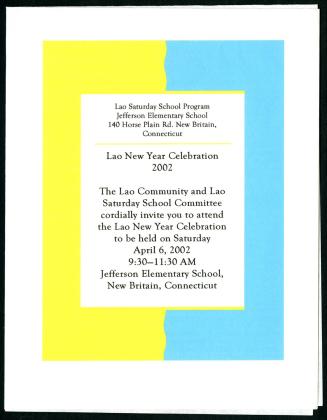Flyers: Lao New Year Celebration, 2002
Date2002
Mediumpaper
ClassificationsInformation Artifacts
Credit LineConnecticut Cultural Heritage Arts Program collections
CopyrightIn Copyright
Object number2015.196.83.42a-b
DescriptionFlyers for Lao New Year Celebration in Killingly, May 5, 2002.
NotesBiographical Note: CCHAP documented Lao activities in eastern Connecticut. Khene player Bounleuane Ketnavong learned to play from his father, and passed on his skills to members of the Lao community in northeastern Connecticut during Years 5 and 6 (2002-2004) of CCHAP’s Southern New England Traditional Arts Apprenticeship Program. Khamphone Phonekeo served as Community Outreach Coordinator in the successful Lao Cultural Program at Killingly Central Schools. Students there participated in activities such as a traditional dance group and New Year Festival. Two of the boys from the group, Sulisay Phonekeo and Khone Thoummany, as well as Khamphone learned khene playing under this apprenticeship. The group presented their learning in a concert at the 2003 Dayville, Connecticut Goodyear School multicultural event showcasing the apprenticeship between teaching artist Bounleaune Ketnavong and Khamphone Phonekeo in Lao khene playing, along with other Lao students at the school. A young dancer, Tamala Phongsavad, learned Lao dance with Manola Sidara and she performed at this event. The apprentices also performed in the Lao New Year Celebration at Jefferson School in New Britain in 2004. Dayville and Killingly in eastern Connecticut had a sizeable Lao population in the 1990s and early 2000s, many were working at the Franklin mushroom farm. After the farm closed, many Lao moved elsewhere in Connecticut and other states.Subject Note: Lao New Year is celebrated in Connecticut by members of the Lao community each April. Known as the Boon Pee Mai or the festival of the fifth month, this is a time of special meals and ceremonies lasting for several days. Traditionally, on the last day of the old year houses are cleaned and put in order as a symbolic activity intended to expel any bad spirits that may be hiding in the home. On the first day of the new year, people go to the temple where they wash the statues of the Buddha with perfumed holy water. The ceremonies ensure good health and prosperity in the new year. In Connecticut, Lao gather at temples for religious ceremonies, and hold special banquets that feature music and dance by local dance groups such as Lao Narthasin led by dance educator and chef Manola Sidara. Other events have included an annual presentation by the students of Lao Saturday School which ran for many years at Jefferson School in New Britain organized by Manola Sidara and Howard and Sue Phengsomphone. Many of these events are organized by the Lao Association of Connecticut. Many Lao New Year celebrations in Connecticut have involved guest artists from other cultural backgrounds and traditions. In 2008 and 2009, CCHAP collaborated with WNPR’s acclaimed radio discussion show "Where We Live" to document several ethnic festivals across the state. Words and sound were woven together to create podcasts and audio slide shows that take viewers and listeners right to the festivals. This project visited and documented a festival at the Lao Temple in Morris.
Subject Note: Connecticut was a major resettlement site for Southeast Asians in the 1980s. The Lao population numbers over 3,000, living primarily in urban areas such as New Britain, Bridgeport, East Hartford, and Danbury and for a time in the 1990s-2007, in rural eastern Connecticut. While many Lao have found employment in factories, service industries, farming, and trades such as food, they continue to face barriers of language, lack of education, and lower income levels, all against a common backdrop of serious emotional wounds from the Viet Nam War era. Youth aged 10-19 years old have been by far the largest age group among Connecticut Southeast Asians. Maintaining young peoples’ awareness of heritage, culture, values, and language is a major goal of Lao leaders and parents. The Lao community sustains its traditional cultural practices in several ways. Several temples around the state provide gathering places where Buddhist monks and nuns offer spiritual services and cultural festivals. The largest temple is in Morris, where the resident monk Khoutavong has created exquisite Buddhist statues and traditional architecture with symbolic carvings, ornamentation, and shrines. Dancer and educator Manola Sidara developed and has directed Lao Narthasin, a traditional dance group now in its third generation of dancers. They perform classical, folk, and social dances that highlight cultural values such as respectful behavior and appreciation for elders. Manola also specializes in creating ceremonial decorations that express wellness, spirituality, and bonding during community celebrations, and she also promotes health and healing through her work as a master chef. The Lao Association of Connecticut (LAC) formed in 1980 to unite the community and assist in economic development, cultural preservation, education, and health. For many years LAC offered classes in language, history, food and medicine, verbal arts, traditional music, and singing at Jefferson School in New Britain, and the group organizes several heritage festivals each year at the Morris temple that are attended by hundreds of Lao people. Other Lao community groups around the state also develop and present spiritual and cultural programs as well as health initiatives.
Additional audio, video, and/or photographic materials exist in the archive relating to these events and this organization.
Cataloging Note: This project was made possible in part by the Institute of Museum and Library Services MA-245929-OMS-20.
Status
Not on view1999-2000
1994-1995
2002-2010
2005-2006















